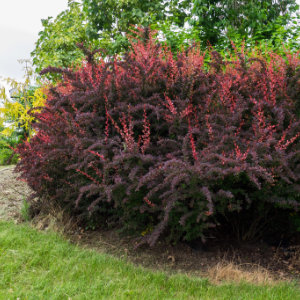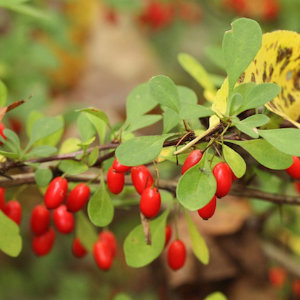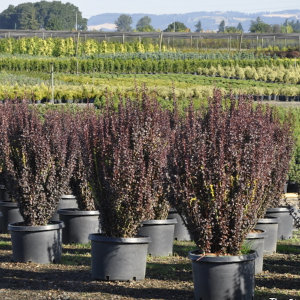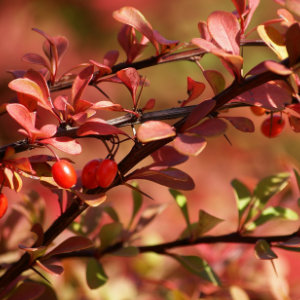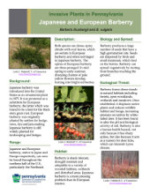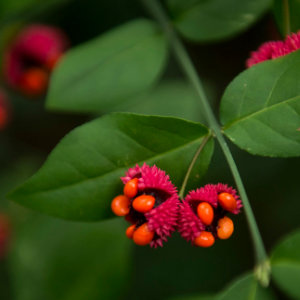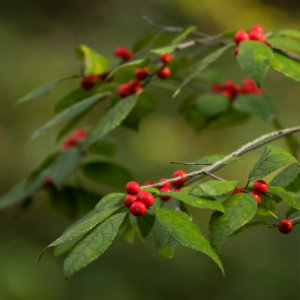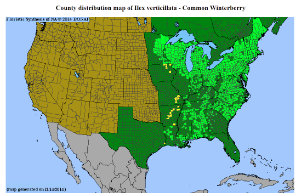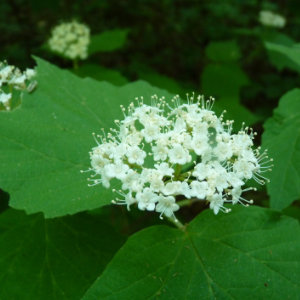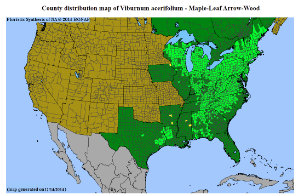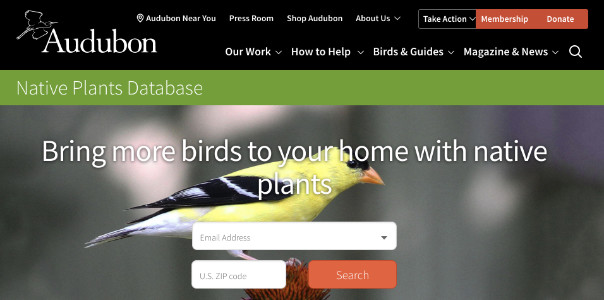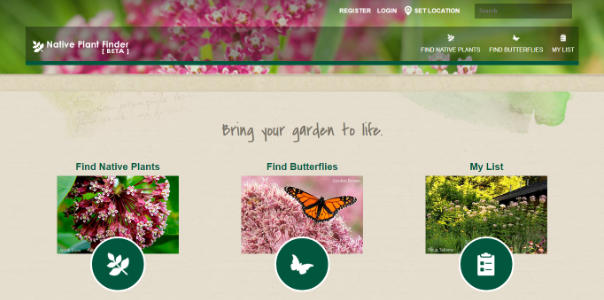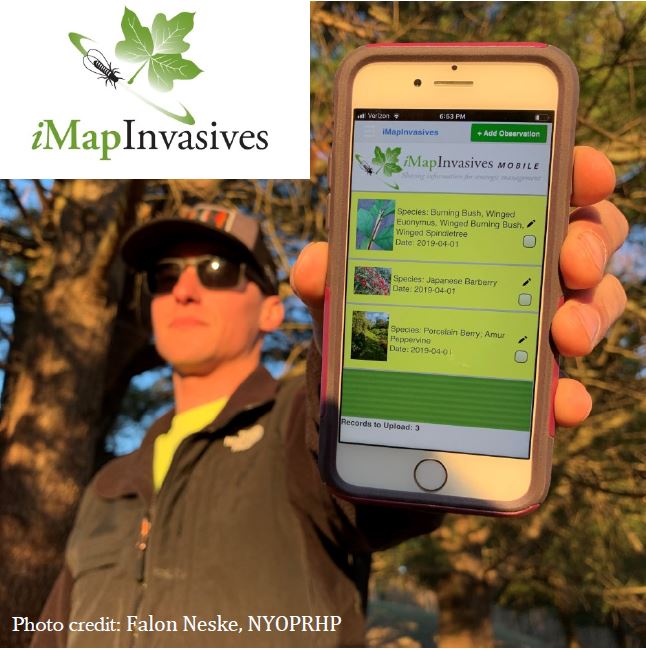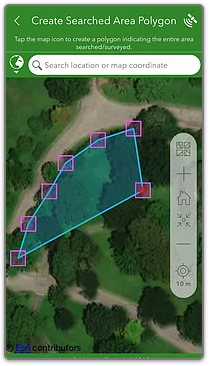Japanese Barberry
Japanese barberry (Berberis thunbergii) is one of the first plants to grow leaves in invaded woodlands in the spring and the last to drop them in the fall. This attractive shrub has red berries that gardeners favor. However, because of its threat to natural habitats, Japanese barberry is banned for sale in several states, but continues to be sold in many locations.
- Credit: F. D. Richards, Berberis thunbergii f. atropurpurea ‘Rose Glow’, 2016, CC BY-SA 2.0
- Credit: Dan Nydick, CC BY-NC 2.0
- Credit: Mark Bolin, Berberis thunbergii ‘Helmond Pillar’, CC BY-SA 2.0
Identification
Japanese barberry is a thorny shrub, usually 1-2 feet high, but can grow up to 6 feet in height. Its glossy leaves taper at the base and are ¾ -2 inches in size. The leaves have smooth edges and resemble a spatula. Leaf colors can be green or reddish-brown. A single, very sharp spine occurs at each node on the plant (where the leaves attach to the stem). In spring, Japanese barberry produces ¼ inch yellow flowers, each with 5 petals. Its egg-shaped berries turn red by fall and persist during the winter.
Common look-alike species include American barberry (Berberis canadensis). Note: American barberry has toothed leaves and multiple spines at the base of its leaves.
Additional information on how to identify Japanese barberry can be found online.
Japanese Barberry: Accurate Identification – Credit: Penn State Extension
Ecological Threat
Japanese barberry is a hardy deciduous shrub commonly planted in many yards, gardens, and landscaped commercial spaces. Birds and mammals eat its fruits and inadvertently spread its seeds, allowing it to quickly take over the understory of nearby woodlands and fields where it crowds out important native shrubs and shades understory plants. Japanese barberry alters the chemistry and microbial composition of soils, fundamentally altering an ecosystem. Researchers have also found that incidence of tick-borne diseases is much higher in areas with Japanese barberry.
Going Rogue: The Story of Japanese Barberry – Credit: University of Minnesota Extension
Control and Removal
If Japanese barberry is present on your property, consider removal and management options. The following resources provide valuable information and tips.
Japanese Barberry – Credit: riverbankmedia
Other management tips can be found at:
Plant Native Alternatives
*This list is not comprehensive, but rather provides a sampling of species available for purchase from retailers located in Pennsylvania and/or surrounding states. All native plant distribution maps (below) are provided by the Biota of North America Program.
- Credit: Arlington National Cemetery, “Hearts-a-burstin in Arlington National Cemetery,” Public Domain
Strawberry Bush (Euonymus americanus)
Strawberry bush grows well in partly shaded areas with moist soil conditions.
- Credit: Chesapeake Bay Program, “Trap Pond State Park in Sussex County, Del.”, CC BY-NC 2.0
Common Winterberry (Ilex verticillata)
Common winterberry prefers areas that receive full sun to part shade and medium to wet soils. It can tolerate poorly drained soils including wet, boggy, or swampy conditions.
- Credit: NatureServe, “Mapleleaf viburnum”, CC BY 2.0
Mapleleaf Viburnum (Viburnum acerifolium)
Mapleleaf viburnum is easily grown in well-drained to medium moisture soils and prefers areas that receive full sun to part shade. Established plants have some drought tolerance.
Learn More and Take Action
Why are Native Plants Important?
Learn more about the importance of planting native plants by reviewing the following resources. And remember, planting even one native plant on your property is a tremendous benefit to wildlife and the environment!
Doug Tallamy Explains, “Why Native Plants?”
Credit: Catherine Zimmerman
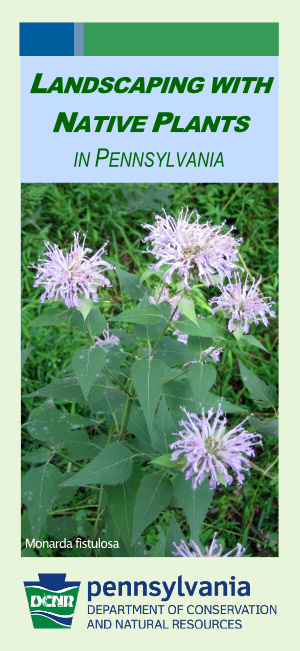
Landscaping with Native Plants in Pennsylvania
Credit: PA Department of Conservation and Natural Resources
Professor Doug Tallamy on Sustainable Landscaping
Credit: University of Delaware
Discover Native Plants.
Learn what plants are native to your area by using the National Wildlife Federation’s Native Plant Finder or the Audubon’s Native Plants Database. Both programs are easy to use - just type in your zip code and a list of native plants is provided to you.
Record Invasive Species Findings with iMapInvasives.
If you find invasive plants and animals in natural areas such as parks, forests, and meadows, please report them to iMapInvasives, an online tool used by natural resource professionals and citizen scientists to record locations of invasive species The iMapInvasives program is useful in understanding species distributions statewide and is used by land managers to prioritize locations to conduct treatment efforts. In Pennsylvania, the iMapInvasives program is administered by the Western Pennsylvania Conservancy and the Pennsylvania Natural Heritage Program and is financially supported by the Great Lakes Restoration Initiative. At the national level, iMapInvasives is administered by NatureServe.
A free registered user account is needed in order to contribute and view data in iMapInvasives. Register here.
How to create a presence record in iMapInvasives online (video)
Connect with Our Experts
Please direct any questions or comments regarding this species profile to Amy Jewitt, Invasive Species Coordinator, or Mary Walsh, Aquatic Zoology Coordinator.

